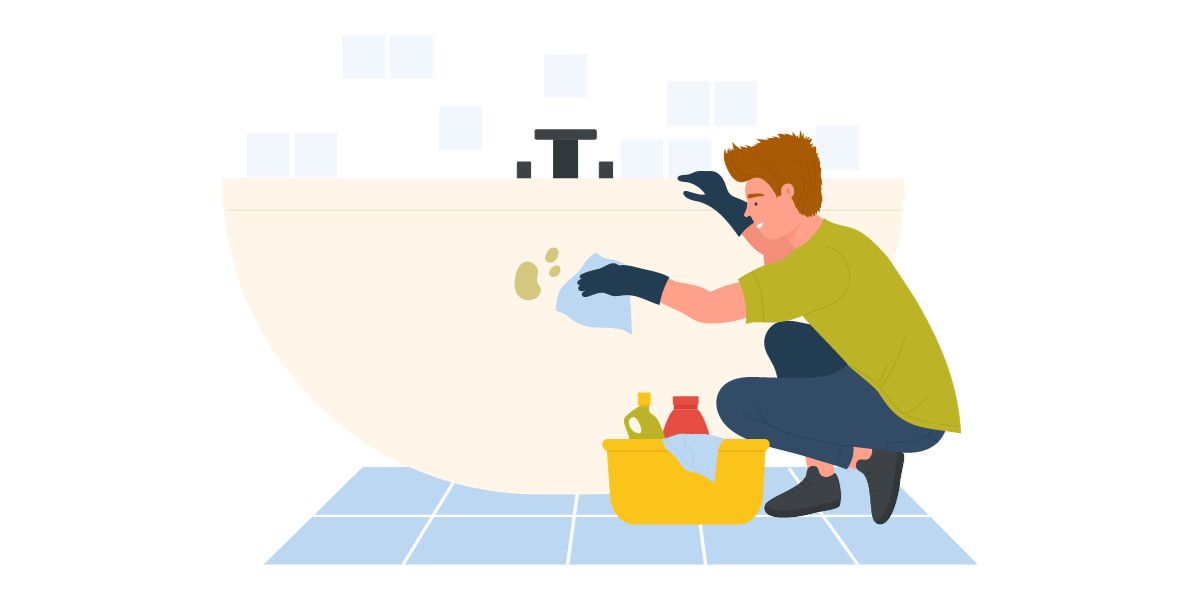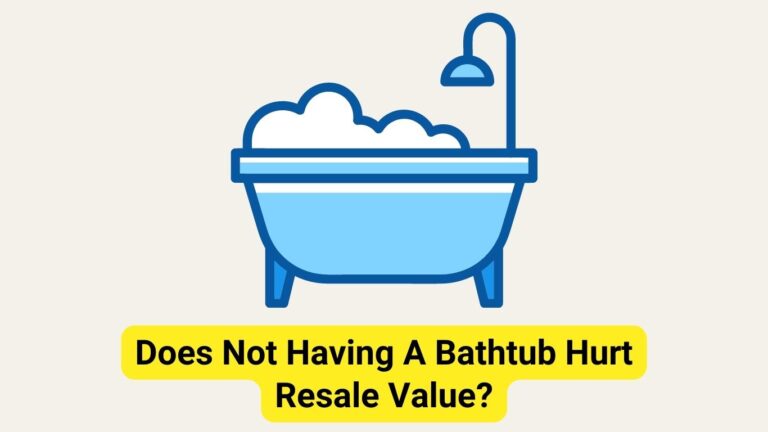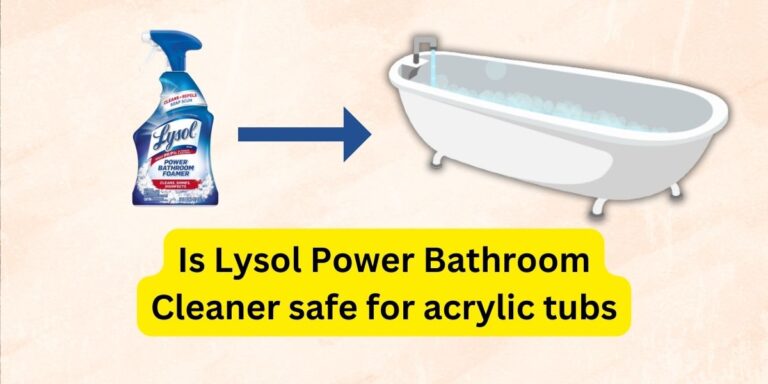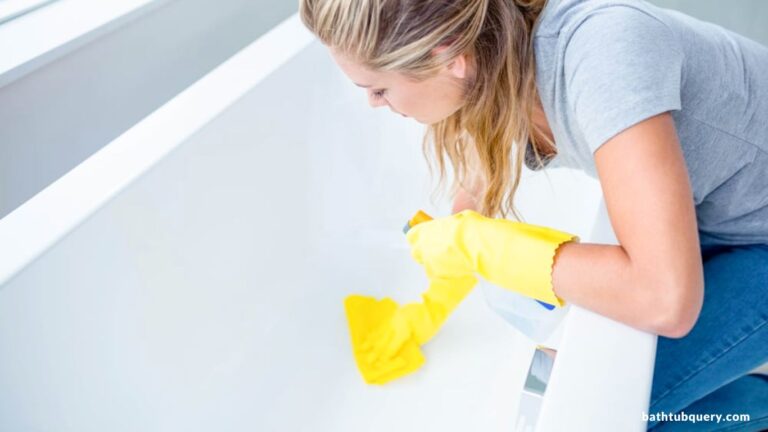I’ve Found Proper Techniques To Clean A Cast Iron Bathtub
Cast iron bathtubs have been around forever, and for good reason – they’re durable, long-lasting, and have a classic elegance that just can’t be beaten. I’ve had a cast iron tub in my 1920s-era home for years now, and while I love the look, keeping it clean has definitely been a learning curve.
These tubs aren’t like your standard porcelain or acrylic ones; they require a bit more care and maintenance to keep them looking beautiful. After years of working to perfect my cleaning routine, I’ve discovered the proper techniques and products that help keep my cast iron tub sparkling.
So here is a quick overview:
To clean a cast iron bathtub without damaging the enamel, fill the tub with warm water and add a small amount of dish soap or detergent. Allow the bathtub to soak for 30 minutes so the diluted cleaner can penetrate grime and buildup. Then use a soft sponge or cloth to gently scrub the tub clean. This method lifts dirt without harming the enamel finish.
Proper Products to Use on Cast Iron
Over the years, I’ve tested every cleaner out there on my tub and found which ones work and which damaged the finish. Let’s just say I learned the hard way not to use anything too harsh! Here are the safest, most effective products I recommend using on a cast iron bathtub:
Mild Dish Soap – My go-to is a small amount of organic dish soap, free from dyes, perfumes, or harsh ingredients. Just a drop or two in warm water works great to lift dirt.
Soft Sponges – I always use a soft cellulose sponge to gently clean the tub. No abrasive scrubbers or anything that could scratch!
Baking Soda – Works like a charm to break down stubborn stains and odors. It’s mildly abrasive but won’t damage the finish.
White Vinegar – Helps cut through soap scum and hard water buildup better than anything. I pour it straight on limescale.
Hydrogen Peroxide – Disinfects and whitens without leaving any chemical residue. I always spray it on my tub after cleaning.
Olive Oil – This pantry staple doubles as a cast iron conditioner. I rub a thin coat on my dry tub anytime it’s looking dull.
As tempting as it is to use harsh bleach or chemical cleaner to remove tough stains in the tub, avoid them at all costs! They will strip the finish right off a cast iron tub. Stick to gentle, natural cleaners only.
How to Clean a Cast Iron Tub Regularly?
Consistent care is so important for cast iron tubs. I quickly learned that wiping down the tub after every use prevents so many headaches down the road. Here’s my routine:
- After each bath or shower, wipe down the entire tub with a soft cloth. This simple habit keeps soap scum, oils, and water spots from accumulating.
- Once a week, I do a deeper clean using baking soda and vinegar. First, I sprinkle baking soda all over and let it sit for a few minutes before scrubbing with a damp sponge. The baking soda sloughs off any grime. For extra shine, I spray or wipe with white vinegar to dissolve soap scum.
- Always rinse the tub thoroughly after cleaning. Any leftover cleaner residue can lead to rust.
- Wiping the tub completely dry after each use prevents rust and mineral deposits from building up. A little water on cast iron can make it rust faster.
I know it takes discipline to clean the tub each time you use it, but it really saves so much time and elbow grease down the line. If you struggle to keep up with cleaning, using a tub insert or liner can also help protect the cast iron between deeper cleanings.
How to Deep Clean a Cast Iron Bathtub?
For a more thorough clean, I recommend doing a deep clean on your cast iron tub every 3-4 months. This is my process:
- Fill the tub with hot water and a small squirt of dish soap – the hotter the better. As a vintage tub owner, I know hot water is key for loosening up that built-up gunk. Let it soak for 15-20 minutes to really penetrate grease and residue.
- Next, I sprinkle a generous amount of baking soda all over the tub and use a soft sponge to gently scrub. The baking soda gives just the right amount of abrasion to get rid of grime without damaging the enamel finish.
- Once I’ve gone over all surfaces, I drain the dirty water and rinse the tub thoroughly. Sometimes I fill the tub again and wipe with a wet towel just to remove all the baking soda residue.
- After cleaning, it’s important to condition the cast iron so it doesn’t rust. I make sure to rub a thin coat of olive oil all over my dry tub; this gives it a beautiful shine while preventing rust.
- To get rid of any musty bathtub smells long-term, placing a small bowl of baking soda in the empty tub will soak up odors.
This entire deep clean process takes me 30-45 minutes, but it leaves my tub looking and feeling like new! The scrubbing gives my arms a workout, so I make sure to stretch really well beforehand, you know?
Protecting the Finish of a Cast Iron Tub
Part of caring for a cast iron tub is taking steps to protect the finish and prevent rust:
- Never allow water to stand in the tub for long periods, as this can lead to rusting. After each use, wipe down and dry the tub fully.
- Consider re-enameling the tub if the finish has become very worn, chipped, or rusting in spots. This can restore the beautiful finish.
- Use rubber bath mats or soft tub liners to protect the bottom from scratches, chips, and erosion over time.
- Apply a thin layer of paste wax to the interior once a year – this acts as a sealant to protect the enamel finish.
- Avoid using any cleaning products that contain bleach, ammonia, or other harsh chemicals that could eat away at the enamel over time.
The enamel finish on old cast iron tubs can become impossible to repair if it wears away and rust takes over. With some simple preventive care, you can keep it looking shiny and new.
Conclusion
After dealing with the trials and tribulations of cleaning my antique cast iron tub over the years, I’ve got a system dialed in that keeps it looking fresh and new. The key takeaways are:
- Use only gentle, natural cleaning products meant for cast iron. Harsh chemicals will damage the enamel.
- Clean regularly with baking soda and vinegar to prevent soap scum, stains, and odors from building up.
- Always wipe and dry the tub fully after use to prevent rust and mineral deposits.
- Deep clean every few months for a thorough scrub.
- Apply paste wax or olive oil periodically to condition the iron and protect the finish.
- Handle the tub and its finish gently. Use rubber mats or liners to prevent scratching and erosion.
With the right tools and techniques, maintaining a vintage cast iron bathtub isn’t difficult. Just remember to clean consistently, use mild cleaners, dry thoroughly, and take steps to protect the enamel.
Follow these tips and you’ll have a tub that looks beautiful for years to come! I’m happy to have finally mastered how to care for my antique tub. Let me know if you have any other cast iron cleaning tips. I’m always trying to learn ways to make my bathroom shine!
Frequently Asked Questions
What is the best thing to clean a cast iron tub?
The best things to clean a cast iron tub are baking soda, white vinegar, and mild dish soap. Baking soda is a gentle abrasive that can break up stains, while vinegar dissolves soap scum. Dish soap combined with warm water helps lift away dirt and oils. Avoid harsh chemicals.
How do you make a cast iron tub look new?
To make a cast iron tub look new again, clean it regularly with baking soda and vinegar. Apply a thin coat of paste wax once a year to protect the finish. Re-enameling a worn tub will restore its glossy surface. Always wipe dry after use.
How do you remove limescale from a cast iron bathtub?
To remove limescale buildup from a cast iron bathtub, spray white vinegar directly onto the limescale deposits. Let it sit for 15 minutes before scrubbing away the deposits with a soft sponge or cloth. The vinegar naturally dissolves mineral deposits like limescale.
Are cast iron tubs easy to clean?
Cast iron tubs are not necessarily difficult to clean, but they do require specific maintenance. Harsh cleaners and abrasives must be avoided as they can damage the enamel finish.

William J. Bullock is a licensed plumber with over 15 years of experience installing and repairing bathtubs. He runs his own plumbing company in Greenville and serves residential and commercial clients. William is dedicated to providing honest, transparent advice to help homeowners make informed decisions about their bathroom renovations.
He has established expertise in selecting bathtubs, planning custom installations, diagnosing issues, and completing repairs. William aims to share practical tips and reliable recommendations based on extensive hands-on work. When he isn’t on a job site, William enjoys spending time with his family and volunteering at local community events. He takes pride in delivering quality service and enjoys helping people upgrade their homes.







